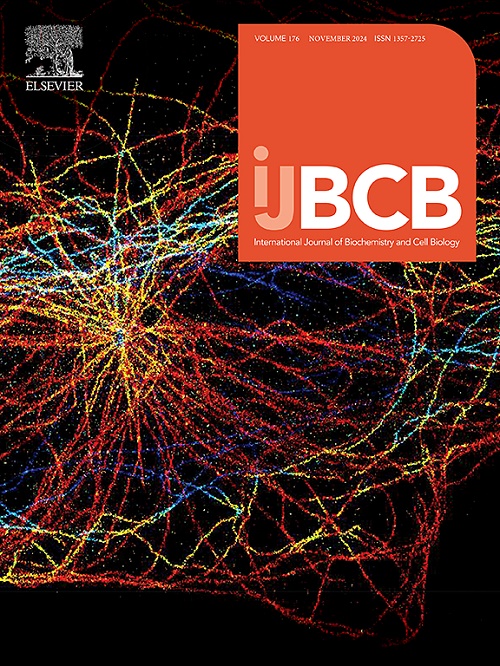Multi-channel smFRET study reveals a compact conformation of EF-G on the ribosome
IF 2.8
3区 生物学
Q2 BIOCHEMISTRY & MOLECULAR BIOLOGY
International Journal of Biochemistry & Cell Biology
Pub Date : 2025-04-08
DOI:10.1016/j.biocel.2025.106782
引用次数: 0
Abstract
While elongation factor G (EF-G) is crucial for ribosome translocation, the role of its GTP hydrolysis remains ambiguous. EF-G's indispensability is further exemplified by the phosphorylation of human eukaryotic elongation factor 2 (eEF2) at Thr56, which inhibits protein synthesis globally, but its exact mechanism is not clear. In this study, we developed a multi-channel single-molecule FRET (smFRET) microscopy methodology to examine the conformational changes of E. coli EF-G induced by mutations that closely aligned with eEF2's Thr56 residue. We utilized Alexa 488/594 double-labeled EF-G to catalyze the translocation of fMet-Phe-tRNAPhe-Cy3 inside Cy5-L27 labeled ribosomes, allowing us to probe both processes within the same complex. Our findings indicate that in the presence of either GTP or GDPCP, wild-type EF-G undergoes a conformational extension upon binding to the ribosome to promote normal translocation. On the other hand, the T48E and T48V mutations did not affect GTP/GDP binding or GTP hydrolysis, but impeded Poly(Phe) synthesis and caused EF-G to adopt a unique compact conformation, which was not observed when the mutants interact solely with the SRL. This study provides new insights into EF-G's adaptability and sheds light on the modification mechanism of human eEF2.
多通道smFRET研究揭示了EF-G在核糖体上的紧凑构象
虽然延伸因子G (EF-G)对核糖体易位至关重要,但其GTP水解的作用仍不清楚。人类真核延伸因子2 (human eukaryotic伸长factor 2, eEF2)在Thr56位点的磷酸化进一步证明了EF-G的不可或缺性,这一磷酸化在全球范围内抑制了蛋白质的合成,但其确切机制尚不清楚。在这项研究中,我们开发了一种多通道单分子FRET (smFRET)显微镜方法来检测大肠杆菌EF-G由与eEF2 Thr56残基密切相关的突变引起的构象变化。我们利用Alexa 488/594双标记的EF-G催化fmet - phe - trnape - cy3在Cy5-L27标记的核糖体内的易位,使我们能够在同一复合体内探测这两个过程。我们的研究结果表明,在GTP或GDPCP存在的情况下,野生型EF-G与核糖体结合后会发生构象扩展,以促进正常的易位。另一方面,T48E和T48V突变不影响GTP/GDP结合或GTP水解,但阻碍了Poly(Phe)的合成,并导致EF-G采用独特的致密构象,这在突变体仅与SRL相互作用时没有观察到。本研究为EF-G的适应性提供了新的认识,并揭示了人类eEF2的修饰机制。
本文章由计算机程序翻译,如有差异,请以英文原文为准。
求助全文
约1分钟内获得全文
求助全文
来源期刊
CiteScore
8.10
自引率
0.00%
发文量
124
审稿时长
19 days
期刊介绍:
IJBCB publishes original research articles, invited reviews and in-focus articles in all areas of cell and molecular biology and biomedical research.
Topics of interest include, but are not limited to:
-Mechanistic studies of cells, cell organelles, sub-cellular molecular pathways and metabolism
-Novel insights into disease pathogenesis
-Nanotechnology with implication to biological and medical processes
-Genomics and bioinformatics

 求助内容:
求助内容: 应助结果提醒方式:
应助结果提醒方式:


